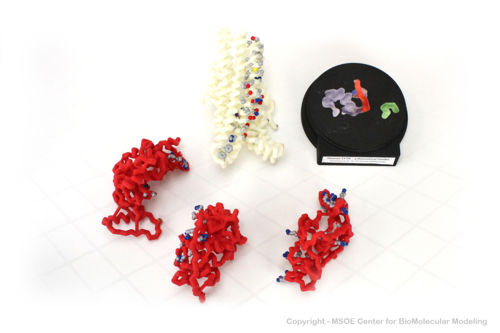The CFTR is a chloride channel, and is regulated by PKA phosphorylation, cAMP levels, and ATP/ADP ratios. Mutations in the CFTR cause the disease cystic fibrosis.
CFTR is a mostly protein. The membrane spanning segments can be clearly seen with coloring by , which shows hydrophobic residues in gray and hydrophilic residues in purple.
The extracellular end of the channel has several residues that are important for recruiting chloride ions to the channel. A number of residues line the channel. In the unphosphorylated state (as this structure is), a blocks the activity of the channel (the connecting segments are not visible in the structure). It contains several negatively charged residues; when the protein is phosphorylated, this segment is repelled, causing a structural change. [1]
CFTR contains two (NBD's), which both contain , flexible loops that bind phosphate groups tightly and are highly conserved among ATP-binding proteins.
Mutations in Cystic Fibrosis
Cystic fibrosis is characterized by decreased chloride transport, which causes mucus to be thicker and stickier. This leads to a variety of problems, including decreased lung capacity, decreased pancreatic enzyme release into the small intestine, increased rates of lung infections, and infertility.[2] There are a wide assortment of mutations that cause cystic fibrosis, with differing symptom severity. The deletion of causes the protein to not be properly synthesized, and no expression is seen on the cell surface. Other mutations are found in the NBD's; some of these mutations such as S1255P alter the responsiveness to MgATP, while others such as G551S, G1244E, and G1239D decrease the frequency of channel opening.
Some of the mutations that lead to cystic fibrosis are due to folding errors. There are in CFTR; they are not sequential in their packing. The presence of in these transmembrane sequences (shown in red) lead to a folding problem: how do you stabilize them until they can be protected by hydrophobic residues and are no longer exposed to the hydrophobic membrane?
3D Printed Physical Model of the CFTR protein
Shown below are 3D printed physical models of the Cystic Fibrosis Transmembrane Conductance Regulator (CFTR) protein. The backbone model on the left is colored by region, with the transmembrane domain white and the atp-binding and regulatory domains colored red. The backbone model on the right is colored by regional repeat, with the first repeat blue, the second repeat green and the regulatory domain colored red. The models have been designed with embedded magnets to disassemble into the key regions of the structure.


The MSOE Center for BioMolecular Modeling
The MSOE Center for BioMolecular Modeling uses 3D printing technology to create physical models of protein and molecular structures, making the invisible molecular world more tangible and comprehensible. To view more protein structure models, visit our Model Gallery.



